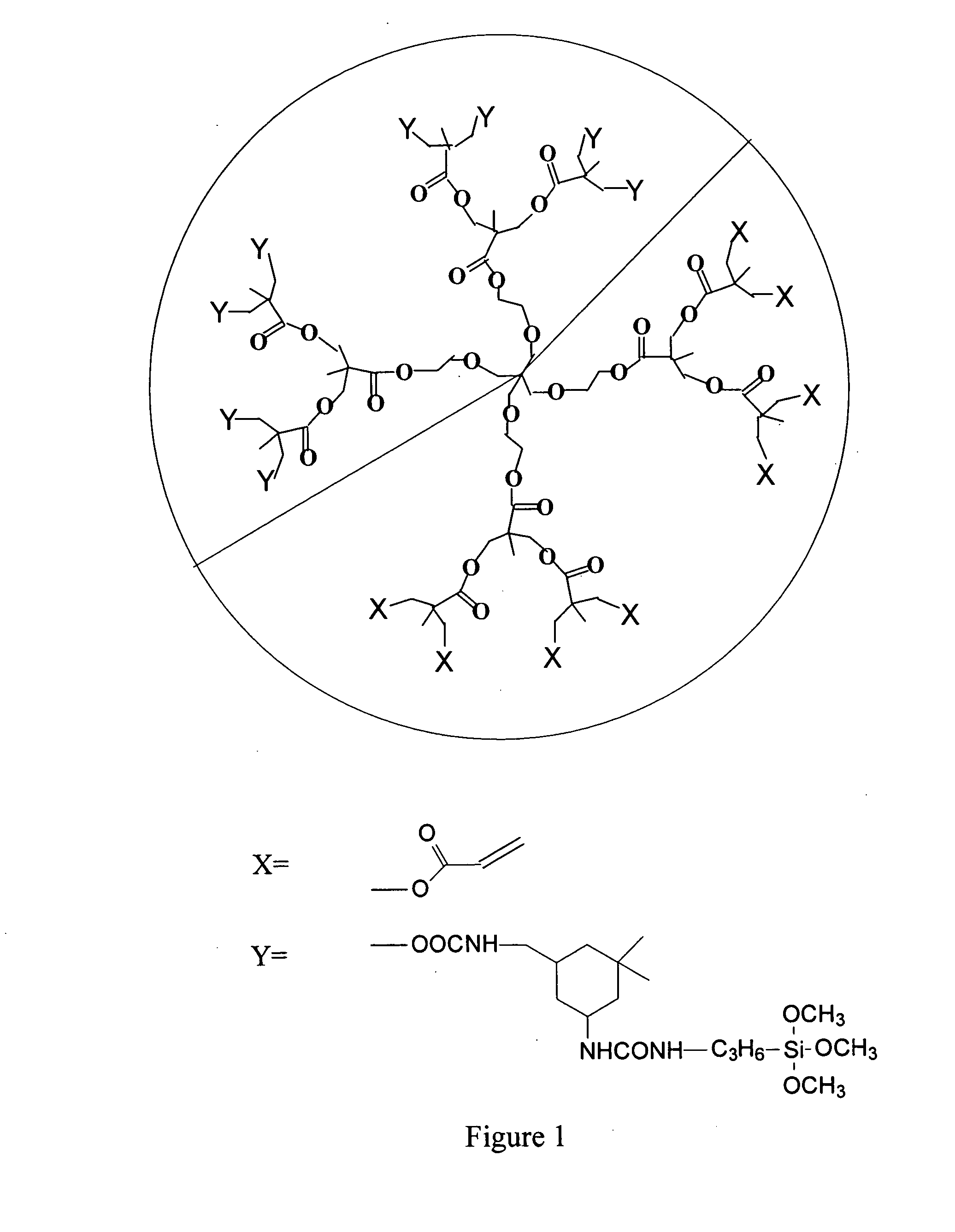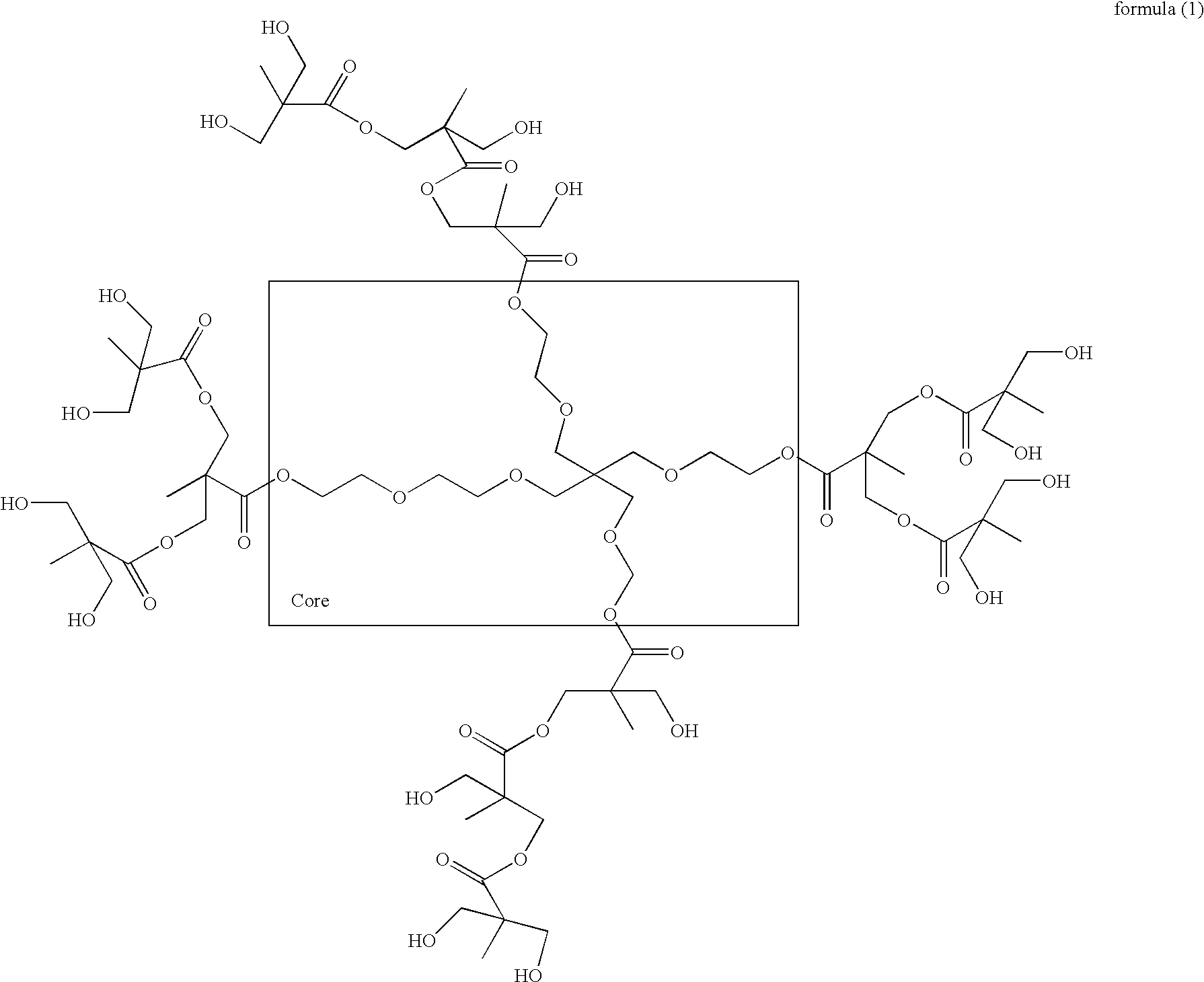Radiation-curable alkoxy silanized hyperbranched polyester acrylates and preparation thereof
a technology of polyester acrylate and radiation cure, which is applied in the direction of impression caps, dental prosthetics, coatings, etc., can solve the problems of hyperbranched polymer and unclear cure film
- Summary
- Abstract
- Description
- Claims
- Application Information
AI Technical Summary
Problems solved by technology
Method used
Image
Examples
example 1
Preparation of Partially Acrylate-Terminated Hyperbranched Polyester with H20 Containing 16 Hydroxyl Groups as a Core by Means of Direct Process
[0036] 20 g (11.53 mmol) H20 was added to a 250 ml three-neck flask reactor, equipped with a magnetic stirrer, a nitrogen inlet, and a condenser water trap, then heated to 160° C. until the H20 was melted to a clear liquid, and then cooled to 100° C. Subsequently, 33.23 g (461.2 mmol) acrylic acid, 1.06 g (2000 ppm) p-hydroxyanisole, and 1.06 g (2000 ppm) p-toluene sulfonic acid were added, and the resulting mixture was stirred and kept at 100° C. After 15 minutes, 60 ml toluene and 60 ml cyclohexane were added, stirred, and heated to the reflux state of toluene, and maintained for 3 hours. After the reaction solution was cooled down, 80 ml dichloromethane was added, and the residual acrylic acid monomer and the p-toluene sulfonic acid were washed off with saturated aqueous NaHCO3 solution, followed by washed with distilled water until a ne...
example 2
Esterification of the Hyperbranched Polyester H30 Containing 32 Hydroxyl Groups with Acryloyl Chloride by the Direct Process
[0039] 20 g (5.55 mmol) H30 was added to the same reaction vessel as that in Example 1, heated to 160° C. until the H30 was melted to a clear liquid, and then cooled to 100° C. Subsequently, the mixture of 50 ml dioxane and 10 ml triethylamine, and 0.04 g (500 ppm) p-hydroxyanisole were added, and acryloyl chloride 8.05 g (88.80 mmol) was added dropwise slowly into the reaction vessel through a dropping funnel with stirring in an ice water bath. After the addition, the reaction was heated to 40° C. and further conducted for 2 hours, washed three times with 1% HCl, and then with saturated aqueous NaHCO3 solution and distilled water until a neutral pH was obtained. Finally, the dioxane was pumped out by distillation under reduced pressure to afford a light yellow liquid; 94% yield.
[0040] The resulting product was analyzed by infrared spectrometry, the character...
example 3
Using the Indirect Process, First Reacting Isophorone Diisocyanate with p-hydroxyethyl acrylate to Give a Monoacrylic Isocyanate, which Subsequently was used to Modify the Hydroxy-Terminated Hyperbranched Polyester H20
[0042] With the same reaction equipment as that used in Example 1, 20.66 g (92.24 mmol) isophorone diisocyanate and 100 ml dioxane were added to a four-neck flask, and 10.7 g (92.24 mmol)p-hydroxyethyl acrylate was added dropwise with stirring while the temperature was controlled below 30° C. until the addition of theo-hydroxylethyl acrylate was completed. And then, the reaction was heated to 35-40° C. and conducted until the isocyanate group value became half of the initial value to afford the monoacrylic isocyanate. The product was cooled to below 30° C., and 20 g (11.53 mmol) H20, 0.092 g (0.2 wt %) dibutyl tin laurate, and 0.04 g (500 ppm) p-hydroxyanisole dissolved in dioxane were added through a dropping funnel. After the addition, the reaction was heated to 65°...
PUM
| Property | Measurement | Unit |
|---|---|---|
| molar ratio | aaaaa | aaaaa |
| temperature | aaaaa | aaaaa |
| acid value | aaaaa | aaaaa |
Abstract
Description
Claims
Application Information
 Login to View More
Login to View More - R&D
- Intellectual Property
- Life Sciences
- Materials
- Tech Scout
- Unparalleled Data Quality
- Higher Quality Content
- 60% Fewer Hallucinations
Browse by: Latest US Patents, China's latest patents, Technical Efficacy Thesaurus, Application Domain, Technology Topic, Popular Technical Reports.
© 2025 PatSnap. All rights reserved.Legal|Privacy policy|Modern Slavery Act Transparency Statement|Sitemap|About US| Contact US: help@patsnap.com


